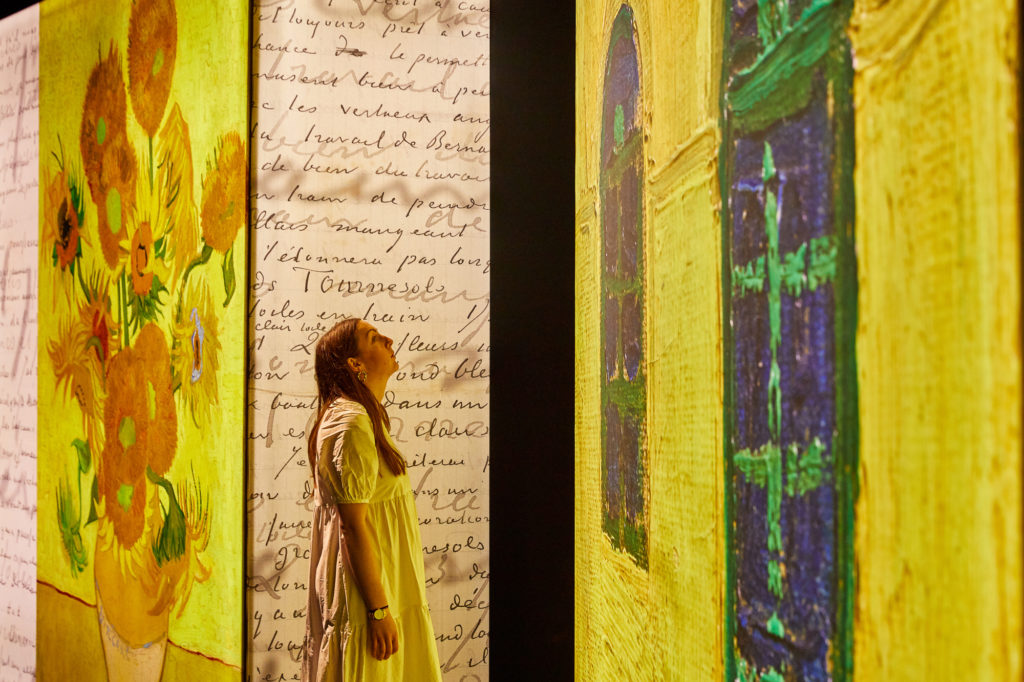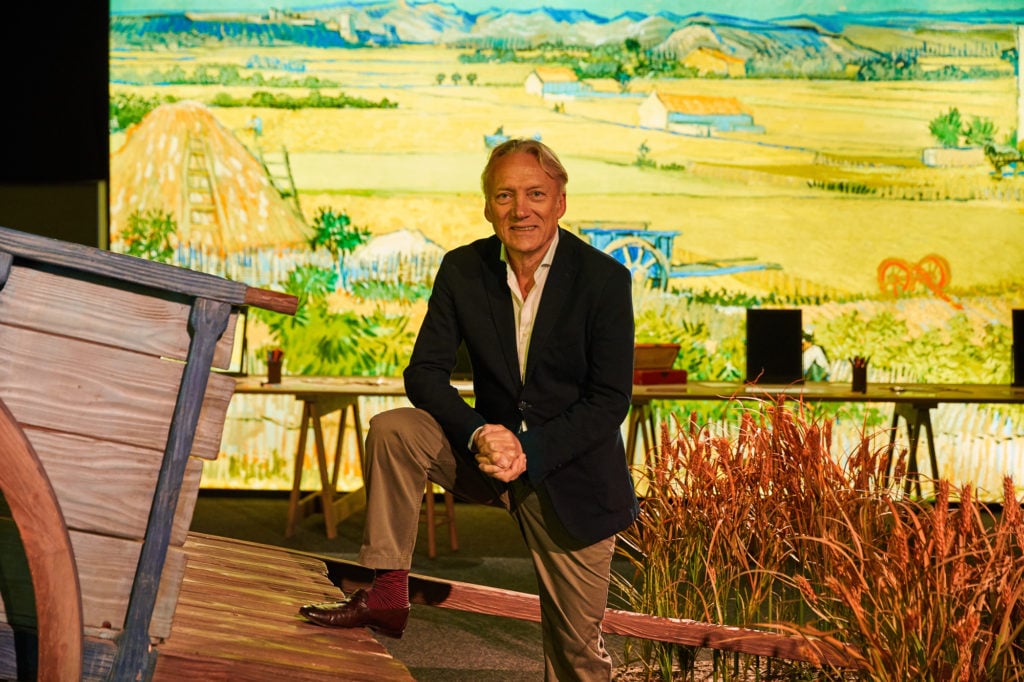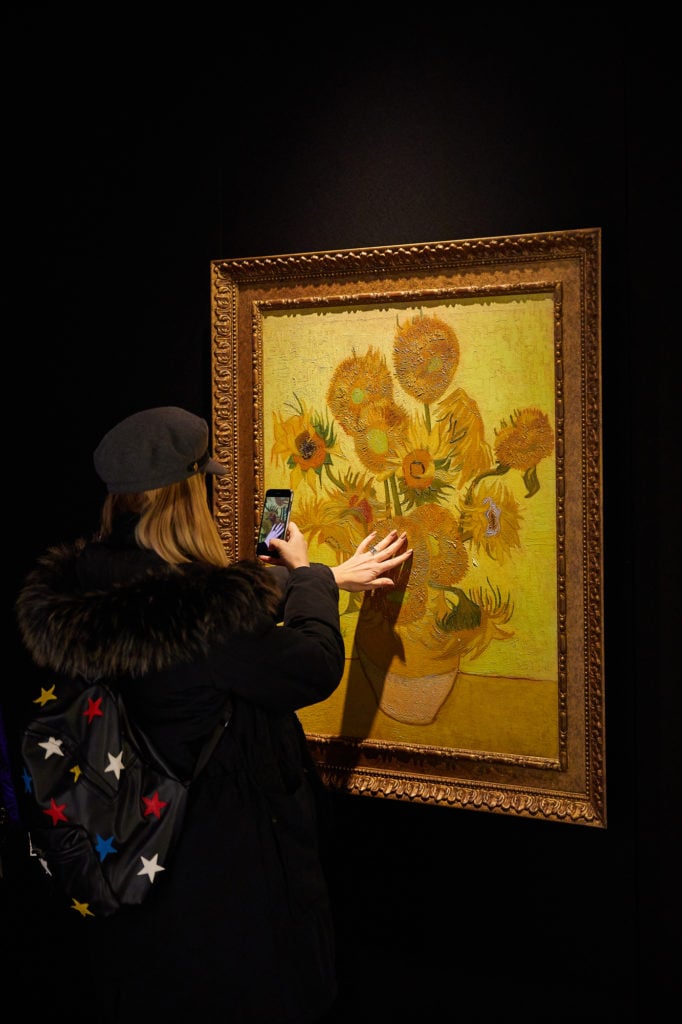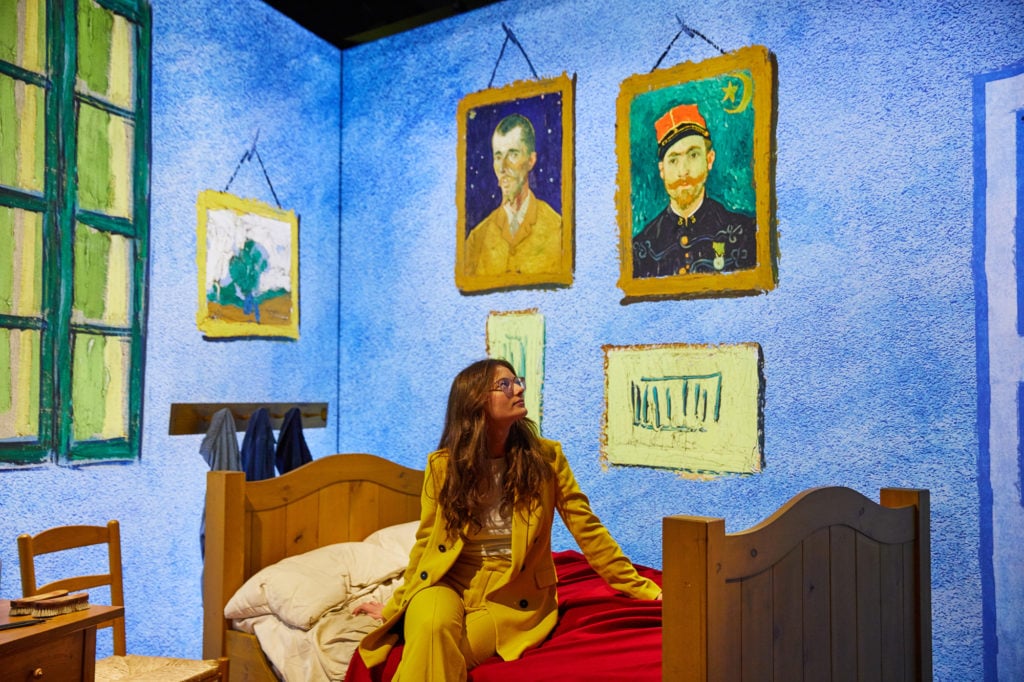Van Gogh is getting the high-tech, 21st-century treatment, as Amsterdam’s Van Gogh Museum brings a new experiential attraction to London.
Titled “Meet Vincent van Gogh,” the pop-up offers up an audio tour of the artist’s life as told through his letters, illustrated along the way by three-dimensional reproductions of famous works, audiovisual scenes, large-scale projections, and interactive activities. You can take selfies in Van Gogh’s bed (or, rather, a snazzy copy of where he slept) or in front of a life-sized backdrop of his yellow house in Arles. Perhaps you want an image of yourself standing in the wheat field where the artist fatally wounded himself? If that’s too morbid, you can watch a shadow play of the artist arguing with Gauguin in his studio.
With no actual art to insure or secure, and previous, popular exhibition runs in Barcelona and Seoul, the experiment could be a good object lesson for cash-strapped museums looking to diversify their income streams. But hopping on the experiential bandwagon is also a risky game. Fun, immersive installations have a reliable track record of bringing in large audiences—and their wallets—but if they’re unsatisfying on an educational level, they run the risk of alienating museums’ existing dedicated audiences, perhaps spelling trouble for an institution’s reputation once the novelty wears off.
Market Demand
“In our mission to develop and explore new ways to reach the audience, we have recognized an evident demand in the market for experiences,” the Van Gogh Museum’s managing director Adriaan Dönszelmann explains. He’s not wrong. A hunger for experiences has been well documented, and the Van Gogh Museum was recently surpassed as one of the world’s most popular single-artist museums by the Tokyo museum dedicated to the immersive light art of the collective teamLab.
This popularity has led to an explosion of fairly empty, populist experiences from commercial operators, while traditional museums have struggled to strike a balance that does not distract from their primary missions of providing a substantive educational or cultural offering.

Installation view of “Meet Vincent van Gogh,” London. Image courtesy of Meet Vincent van Gogh. Photo by Luke Walker.
Dönszelmann notes that there has specifically been an increasing demand for a Van Gogh experience. If this sounds familiar, you might recall an experience called Van Gogh Alive, or another popular project, organized by the Atelier des Lumières in Paris, which immerses viewers in vast light projections of the Dutch artist’s masterpieces (the same company also ran a similar experience centered around Gustav Klimt).
Dönszelmann all but name-checked these previous operators, but emphasized that “Meet Vincent van Gogh” is “the one and only official experience created by the Van Gogh Museum.” The director says that the museum’s offering is “totally different” from the other Van Gogh offerings on the market, explaining that unlike its flashy and not very cerebral predecessors, it is meant to be a “complete” experience in which education and entertainment go hand in hand.
Necessity Is the Mother of Invention
But why would a thriving museum need something like this in the first place? The Van Gogh Museum in Amsterdam welcomes around 2.2 million visitors each year, but Dönszelmann says this income is “vulnerable.”
“It is important for the museum to broaden the sources of income,” Dönszelmann says. “So by doing this we are generating income in a new way.”
The experience certainly has the potential to become serious driver of cash. When “Meet Vincent van Gogh” was launched in Barcelona, it drew 160,000 people; more than 80,000 turned up in Seoul. Before the experience opened in London, they had already pre-sold just under 20,000 tickets. Full price tickets will set you back £18 (around $23), which is more than the €19 ($20) that it costs to enter the actual museum back in Amsterdam. The space in London can accommodate up to 5,000 people a day, and because it does not contain original artworks, the museum soon hopes to be able to roll out the experience simultaneously in multiple locations.

Installation view of “Meet Vincent van Gogh,” London. Image courtesy of Meet Vincent van Gogh. Photo by Luke Walker.
Beyond diversifying revenue streams, there is the practical point that many historic works are becoming too fragile to travel. Transporting and insuring valuable pieces is also a costly endeavor. Meanwhile, the demand for culture is growing outside of major cities, and there has been an ongoing discussion about touring digital renderings of artworks to meet this demand. Right now in France, for example, the culture ministry is rolling out an ambitious project to introduce 1,000 “digital museums” around the country and its territories in order to share the masterpieces in its national collection more widely.
“I do think that in the future we will see more museums operating in this sphere,” Arnold van de Water, the general manager of the experience for the Van Gogh Museum, tells Artnet News. “I like that we can cross borders, and not be afraid to say that museums can learn a lot from the entertainment industry. I think that that works both ways.”
Van Gogh’s works are particularly fragile. After an extensive restoration effort, the museum announced a travel ban on Van Gogh’s Sunflowers last January. Van de Water says that logistical realities like this have forced the institution to get creative in order to fulfill its mission of making Van Gogh’s life and work accessible to as many people as possible. He added that as a single-artist museum they are always thinking about fresh ways to continue engaging audiences.
“It’s not only about eye candy or video projections,” Van de Water stresses, noting that the content of the experience came out of scientific research carried out by the museum over the past 50 years. “Meet Vincent Van Gogh” might be flashy and fun, but it was designed in tandem with the museum’s curatorial staff and education department. “We publish books, we create documentaries, and I think creating an experience like this is another form of telling that same story,” Van de Water says.
Audience Satisfaction
Asked what type of audience the museum hopes to draw here, Van de Water says that it was designed as “an experience for novices and experts alike.”
The trouble with such an ambitious remit is that it means that “Meet Vincent van Gogh” has to simultaneously contend with the expectations of London audiences familiar with museums like the nearby Tate Modern, as well as with fans of high-budget, sensational selfie-factories like the Museum of Ice Cream.

Installation view of “Meet Vincent van Gogh,” London. Image courtesy of Meet Vincent van Gogh. Photo by Luke Walker.
So what’s it actually like to “meet” Vincent van Gogh in this way? For me, the rather unspectacular displays fell flat. They neither satisfied my millennial hankering for an experience worthy of my Instagram grid, nor did they take the place of going to a real museum to experience the original works of art. I was particularly disappointed in the lack of truly high-tech wizardry. Why not have us meet a VR Van Gogh? Or ask: Can we teach a computer to paint like the master?
But perhaps I’m not the exact target demographic. The show’s organizers don’t seem worried, and after speaking to a number of people attending the exhibition, I can see why.
Most of those I talked to about the experience reacted positively. Admittedly, those who enjoyed themselves tended not to hail from the creative industries: they were finance and luxury wholesale industry workers, teachers, and social workers. Tech industry worker Maria Koutoumanou said that it was a “missed opportunity” to experiment with more advanced technologies, but that she enjoyed the experience overall.
“Meet Vincent van Gogh” was especially popular with families. I received overwhelmingly positive feedback from those with young children. Kids were a fan of the interactive activities, where you can draw using a perspective frame, or try your hand at your own self-portrait. Ten-year-old Tillie Richardson and her teenage brother Jack both deemed it “really interesting,” and said that they enjoyed the experience even more than the King Tut exhibition at Saatchi Gallery. (That’s high praise, given that the King Tut show, currently ongoing in London, drew 1.4 million visitors during its Paris run.)
While I was not satisfied by the experiential component, I can see the potential for this type of museum-run standalone exhibition to bring in money and educate new audiences. It might also be a way to give avid selfie-takers a place to run wild, which could give actual museums a break from the social-media frenzy. It is an interesting first step; but if the museum wants to tap into where the real money is at, which is in the hands of experience-hungry Millennial and Gen Z visitors, they need to up the ante. To capture such jaded attention spans, institutions will have to serve up something more than what these young visitors can already get on their screens.
“Meet Vincent van Gogh” is on view at 99 Upper Ground, South Bank, London, through May 21.
Follow Artnet News on Facebook:
Want to stay ahead of the art world? Subscribe to our newsletter to get the breaking news, eye-opening interviews, and incisive critical takes that drive the conversation forward.









